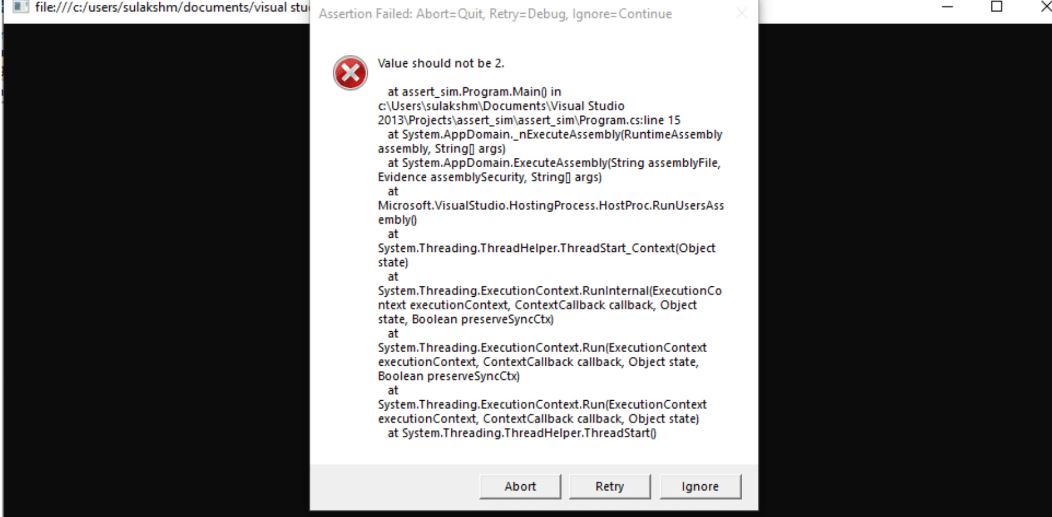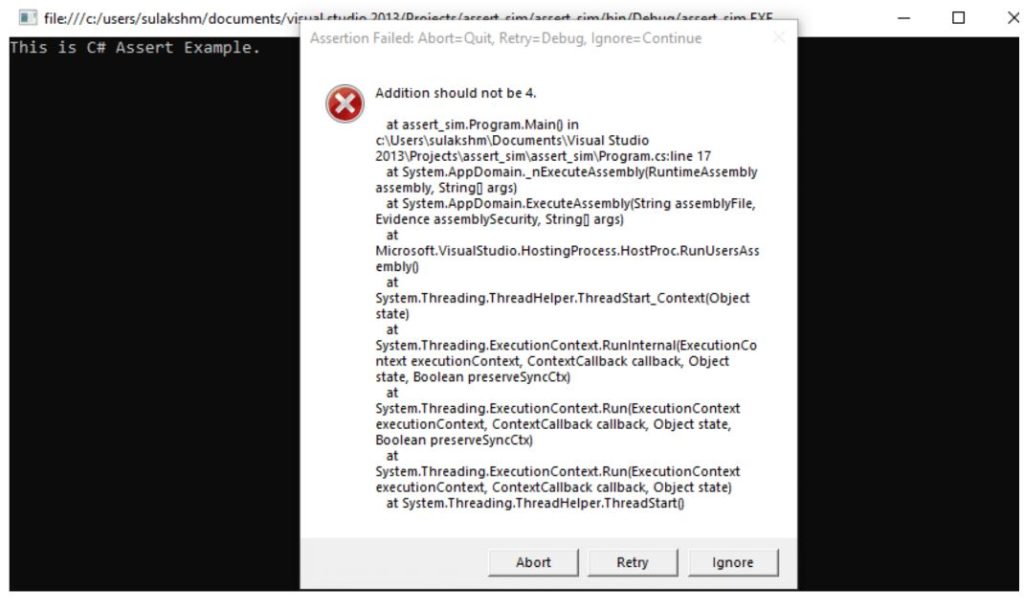Updated April 1, 2023

Introduction to Assert in C#
The following articles provide an outline on Assert in C#. The assert method is one of the most effective methods to detect logic errors at runtime and making it easy to correct the error at the production level. An assert method generally takes 2 arguments: one is a boolean expression and another is a message to be displayed. While the assert method takes two arguments, there must not be a single function inside the assert method and in no shall it has any impact on the out of the program, in any way. The assert method is convenient to implement in large programs, where it allows programmers to easily detect and clear errors.
Syntax:
Debug.Assert();Above debug.assert method is part of System.Diagnostics class and provides a way to speedily implement the function. Debug class varies from Trace class where it is only included in Debug Build, while Trace class is included in Debug and Release Build. It is advisable to not to use any specific function call inside this assert method in any part of the program. It is important to understand that the inside function shall not have any impact on output.
How Does Assert work in C#?
While defining an assert method we have to pass two arguments, one is a boolean value and another is to be a message that must be displayed. Assert method works with having either True or False:
- While defining an assert method it is important to assign what to display if it is false.
- And must have a boolean expression for when the condition is true.
When a program encounters the assert method, it will check for the condition. The program will be interrupted and will inform you the condition is not met. If the condition is false, the second argument which is a message will be displayed. The program will proceed in case of the condition is true.
Basically, when we have inserted an assert at any point in the program, if the condition is found to be false, it will interrupt the normal execution of the program and display a dialog box with details.
Examples of Assert in C#
Given below are the examples are mentioned:
Example #1
An assert method with simple integer with any specific function.
Code:
using System;
using System.Diagnostics;
namespace assert_sim {
static class Program {
public static void Main() {
int val = 2;
Debug.Assert(val != 2, " Value should not be 2.");
}
}
}Code Interpretation:
- We have our two import classes, System.Diagnostics is important as it speeds up the implementation of assert function later in program.
- We have our class and main method, later integer value with 2 as value.
- Debug.Assert implements the assertion statement and checks for the condition. As stated in code, if the value is not equal to (!=) 2, the code is proceed ahead without any interruption. But if the value assigned is 2 then a message box will be displayed with message, “Value must never be 2”. After the assert encounter, program will execute as it must.
Output:
When the value was 2, as explained earlier, dialog was displayed with message, “Value must never be 2” along with details of the error. Message will display the line number where it caught the assert method.
Example #2
Addition of two numbers and will pass on to assert method for condition.
Code:
using System;
using System.Diagnostics;
namespace assert_sim {
static class Program {
public static void Main() {
int x = 2;
int y = 2;
int q = x + y;
Console.WriteLine("This is C# Assert Example.");
Debug.Assert(q != 4, "Addition should not be 4.");
Console.WriteLine("\n This is after assert method.");
Console.ReadLine();
}
}
}Code Interpretation:
- Everything is similar to program1. In our second program we have declared 3 integer variables and assigned respective values.
- Later, we have simple addition function and the output of the addition will be sent to assert method to evaluate.
- Next we have our print statement which simply prints a line stating “This is C# Assert Example.”
- Then our program enters assert method and condition is check. Our addition will result in 4, and condition not to have it 4. As our program addition will result in 4, the message will be printed on a dialog box, “Addition should not be 4.” after assert method, the program will execute as it is directed and the next statement will be printed.
Output:
And, clicking on Ignore button, the dialog box will disappear and the last line will be printed.
Advantages of C# Assert
With every specific method or function in programming language, we have multiple advantages, just like that following are the advantages of using assert method in c#:
- One of the biggest advantage is the ability to spot errors in the program that might have not been noticed.
- Other than finding the bugs, implementation of assert method can be way useful to detect these error sooner, making it faster to solve the issue.
- Always True: With assert method, you have a statement that explains the impact of the specific code, which is assured to be true.
- The assert method makes sure that the programmer has enough time to detect, understand and solve the error.
Conclusion
Assert method is simply used to identify errors in runtime. Assert Method takes two arguments, first is a boolean expression, where the condition is checked, and second is message to display based on the result of the condition. We demonstrated two examples to understand the working of the assert method. One of the best applications for Assert is to implement it with quite a large program, as it makes the process of locating and quickly removing the errors.
Recommended Articles
This is a guide to Assert in C#. Here we discuss the introduction, how does it works, and advantages. You may also have a look at the following articles to learn more –



